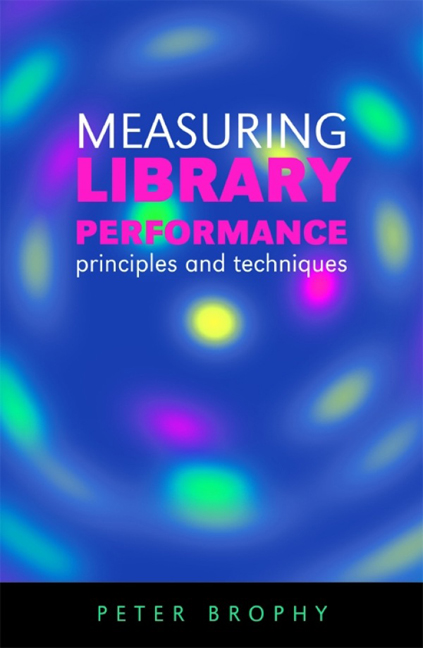Book contents
- Frontmatter
- Contents
- List of figures
- List of tables
- Preface
- Acronyms and abbreviations
- 1 Background
- 2 Theoretical considerations
- 3 User satisfaction
- 4 Impact on users
- 5 Social and economic impact
- 6 Inputs
- 7 Processes
- 8 Outputs
- 9 Staff
- 10 Infrastructure
- 11 Services for all
- 12 Benchmarking
- 13 The balanced scorecard
- 14 Standards
- Appendix 1 Data collection methods
- Appendix 2 The analysis of data
- Appendix 3 The presentation of results
- Index
- Frontmatter
- Contents
- List of figures
- List of tables
- Preface
- Acronyms and abbreviations
- 1 Background
- 2 Theoretical considerations
- 3 User satisfaction
- 4 Impact on users
- 5 Social and economic impact
- 6 Inputs
- 7 Processes
- 8 Outputs
- 9 Staff
- 10 Infrastructure
- 11 Services for all
- 12 Benchmarking
- 13 The balanced scorecard
- 14 Standards
- Appendix 1 Data collection methods
- Appendix 2 The analysis of data
- Appendix 3 The presentation of results
- Index
Summary
■ Introduction
The days when a service organization could ignore its customers and concentrate on its internal targets are long gone. Hopefully, all libraries have moved away from the customer-as-nuisance viewpoint, what Moore (1992) characterized as the ABC (Another Bloody Customer) approach to customer service:
all too often we are made to feel that simply by being a customer we are trespassing upon someone's leisure time; or making their life unnecessarily complicated. In some cases, usually in shops selling computers or hi-fi equipment, we are made to feel that, as customers, we fail to come up to the intellectual level of the people serving us.
Libraries now accept that they must be user-centred and show empathy with their customers. In other words, the focus of all their services needs to be on the individuals and groups who will make use of them, rather than on the library's own processes or on the materials and other resources which the library collects or to which it provides access. A small caveat needs to be added to this statement to recognize that many national and specialist libraries do focus on collection development, conservation and preservation. However, even in these cases, users of the future inform decisions on acquisition, retention and conservation priorities in the present. It follows that statements of library purpose, which as Chapter 1, ‘Background’, suggested need to drive performance measurement, will have a clear user focus.
The idea of focusing on users, or customers, has a long history. In librarianship it was most memorably expressed by the Indian librarian S. R. Ranganathan in his ‘laws of library science’, formulated 75 years ago (Ranganathan, 1931):
• books are for use
• every reader his book
• every book its reader
• save the time of the reader
• a library is a growing organism.
Interestingly, this approach preceded the adoption of similar principles in industrial and commercial organizations, which only really started to adopt customer-focused approaches in the aftermath of World War 2. A series of influential figures, known as the ‘quality gurus’, started to promote the idea that the quality of a product or service could only be assessed by reference to the intended user and the intended use.
- Type
- Chapter
- Information
- Measuring Library Performanceprinciples and techniques, pp. 35 - 53Publisher: FacetPrint publication year: 2006



